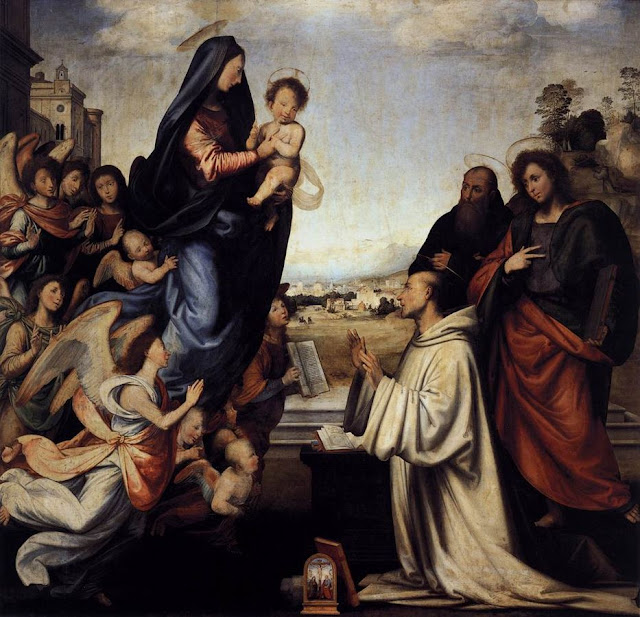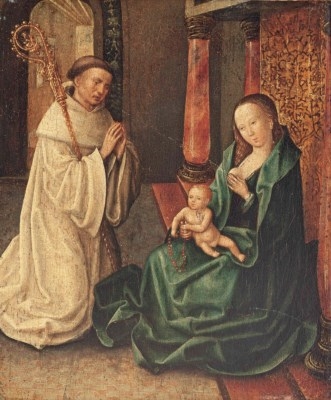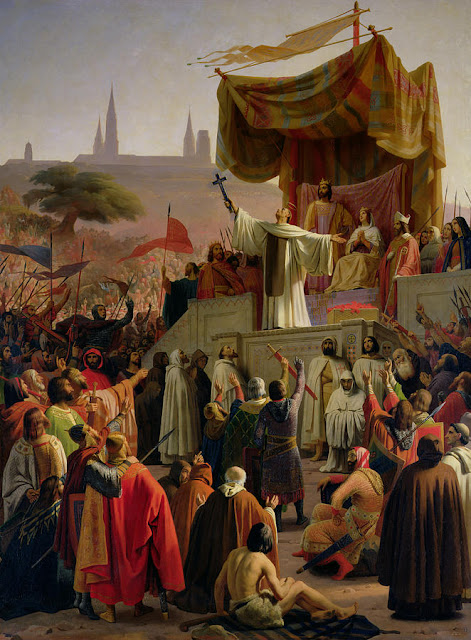The painting shows the French abbot saint Bernard of Clairvaux (1090 – 1153) who is writing on his lectern. The saint is visited by the virgin Mary with several angels. Behind the saint, in a small cave, a devil is biting his chains - this is a reference to mary as the liberator of humanity from the chains of their sins. Above the saint, in the upper right corner, several Cistercian monks can be seen - saint Bernard of Clairvaux was a reformer of this order. The man in lower right corner is the patron Piero di Francesco Del Pugliese. Painting from 1480. More on this work
Filippino Lippi, (born c. 1457, Prato, Republic of Florence—died April 18, 1504, Florence) early Renaissance painter of the Florentine school whose works influenced the Tuscan Mannerists of the 16th century. After his father’s death, Filippino entered the workshop of Botticelli. By 1473 he had finished his apprenticeship. The style of Filippino’s earliest works stems from that of Botticelli, but Filippino’s use of line is less sensitive and subtle than Botticelli’s. In a group of paintings executed about 1480–85 he developed a harder and more individual style. Among the most notable works of this period is the Journey of Tobias (above). He was employed, along with Botticelli, Perugino, and Domenico Ghirlandaio, on the frescoed decoration of Lorenzo de’ Medici’s villa at Spedaletto and at the end of 1482 was commissioned to complete work left unfinished by Perugino in the Palazzo della Signoria in Florence. No trace of either work survives. Soon after (probably 1483–84) he was entrusted with the completion of the frescoes in the Brancacci Chapel in the Carmine, which had been left unfinished on Masaccio’s death in 1428.
After his return from Rome, Filippino executed a fresco of the Death of Laocoön for the villa of Lorenzo de’ Medici at Poggio a Caiano, in which some of the decorative devices used in the Carafa Chapel are again employed, and resumed work in the Strozzi Chapel (completed 1502), the frescoes of which anticipate Tuscan Mannerism of the 16th century. More on Filippino Lippi
He was sent to found a new abbey at an isolated clearing in a glen known as the Val d'Absinthe. According to tradition, Bernard founded the monastery on 25 June 1115, naming it Claire Vallée, which evolved into Clairvaux. There Bernard preached an immediate faith, in which the intercessor was the Virgin Mary. In the year 1128, Bernard attended the Council of Troyes, at which he traced the outlines of the Rule of the Knights Templar, which soon became the ideal of Christian nobility.
The Virgin appears miraculously to Saint Bernard to offer him her milk as a reward for his praises and defense. The Saint is surprised while studying and falls to his knees.
Rogier van der Weyden (1399 or 1400 – 18 June 1464) was an Early Netherlandish painter. His surviving works consist mainly of religious triptychs, altarpieces and commissioned single and diptych portraits. He was highly successful and internationally famous in his lifetime; his paintings were exported – or taken – to Italy and Spain, and he received commissions from Netherlandish nobility and foreign princes. By the latter half of the 15th century, he had eclipsed Jan van Eyck in popularity. However his fame lasted only until the 17th century, and largely due to changing taste, he was almost totally forgotten by the mid-18th century. His reputation was slowly rebuilt during the following 200 years; today he is known, with Robert Campin and van Eyck, as the third of the three great Early Flemish artists, and as the most influential Northern painter of the 15th century. Karel van Mander wrote that the great artistic contribution of Rogier van der Weyden lies in his ideas, his composition and rendering of the soul's expression through pain, happiness or anger, and the tempering of this emotional testimony to the subject matter of his work.
Van der Weyden worked from life models, and his observations were acute, yet he often idealised certain elements of his models' facial features, and they are typically statuesque, especially in his triptychs. All of his forms are rendered with rich, warm colourisation and a sympathetic expression, while he is known for his expressive pathos and naturalism. His portraits tend to be half length and half profile. Van der Weyden used an unusually broad range of colours and varied tones; in his finest work the same tone is not repeated in any other area of the canvas; even the whites are varied. More on Rogier van der Weyden
The Lactation of St Bernard is based on a miracle or vision concerning St Bernard of Clairvaux where the Virgin sprinkled milk on his lips. In art he usually kneels before a Madonna Lactans, and as Jesus takes a break from feeding, the Virgin squeezes her breast and he is hit with a squirt of milk. The milk was variously said to have given him wisdom, shown that the Virgin was his mother, or cured an eye infection. In this form the Nursing Madonna survived into Baroque art, and sometimes the Rococo, as in the high altar at Kloster Aldersbach. More on the Nursing Madonna
On the death of Pope Honorius II on 13 February 1130, a schism arose in the church. King Louis VI of France convened a national council of the French bishops at Étampes in 1130, and Bernard was chosen to judge between the rivals for pope. By the end of 1131, the kingdoms of France, England, Germany, Portugal, Castile, and Aragon supported Pope Innocent II; however, most of Italy, southern France, and Sicily, with the Latin patriarchs of Constantinople, Antioch, and Jerusalem supported Antipope Anacletus II. Bernard set out to convince these other regions to rally behind Innocent.
In 1139, Bernard assisted at the Second Council of the Lateran. He subsequently denounced the teachings of Peter Abelard to the pope, who called a council at Sens in 1141 to settle the matter. Bernard soon saw one of his disciples elected Pope Eugene III.
After the Christian defeat at the Siege of Edessa, the pope commissioned Bernard to preach the Second Crusade. The last years of Bernard's life were saddened by the failure of the crusaders, the entire responsibility for which was thrown upon him. Bernard died at the age of 63, after 40 years as a monk. He was the first Cistercian placed on the calendar of saints, and was canonized by Pope Alexander III on 18 January 1174. In 1830 Pope Pius VIII bestowed upon Bernard the title "Doctor of the Church".
Please visit my other blogs: Art
Collector, Mythology, Marine
Art, Portrait of a Lady, The
Orientalist, Art of the Nude and The
Canals of Venice, Middle
East Artists, and 365 Saints, also visit my Boards on Pinterest
Images are copyright of their respective owners, assignees or others.
Some Images may be subject to copyright
I don't own any of these images - credit is always given when due unless
it is unknown to me. if I post your images without your permission, please tell
me.
I do not sell art, art prints, framed posters or reproductions. Ads are
shown only to compensate the hosting expenses.
If you enjoyed this post, please share with friends and family.
Thank you for visiting my blog and also for liking its posts and pages.
Please note that the content of this post primarily consists of articles
available from Wikipedia or other free sources online.









No comments:
Post a Comment
Note: Only a member of this blog may post a comment.